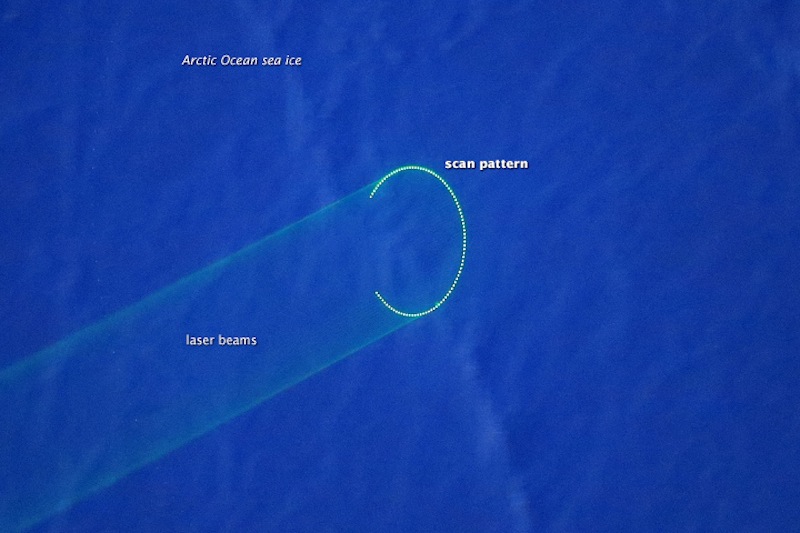Spooky Ring of Light Created by Arctic's Ice-Mapping Lasers (Photo)

It may look like the setting for a sci-fi film, but a new photo of a backward-C-shaped pattern of lights against a desolate blue background has a more terrestrial origin.
The image, released April 5 by NASA's Earth Observatory, shows pulses of laser light hitting Arctic sea ice — the ice that forms and floats in Arctic waters.
Every spring, scientists with NASA’s Operation IceBridge mission use a modified P-3 research plane to monitor conditions at the poles. As part of this year's campaign, researchers flew across the North American side of the Arctic Ocean, traveling from north of Greenland, past Canada, and to Alaska. All the while, instruments in the belly of the plane peered downward, monitoring the Arctic’s dwindling ice. [Images of Melt: Earth's Vanishing Ice]
The so-called Digital Mapping System (DMS), a camera that photographs the terrain below, is one of 14 instruments aboard the Operation IceBridge plane. It typically captures images of snow dunes glistening in the sunlight, patches of ice broken up against the black sea and the flowing patterns of blue glaciers. But catching laser beams hitting the icy surface was a lucky find, according to NASA.
The ethereal image was captured during the first few hours of twilight, and the lack of sunlight at this time revealed this typically invisible feature, according to Sinéad Farrell, an assistant research scientist at the University of Maryland, College Park, and a member of the Operation IceBridge science team.
The beams in the photo are streaming down from the Airborne Topographic Mapper (ATM), an instrument located next to the DMS on the underbelly of the airplane. The photo shows the scan pattern of the instrument as it sends out 94 laser pulses in 1/30 of a second — the length of time that the DMS shutter was open, according to NASA scientists.
Scientists beam lasers onto the ice below and calculate the time it takes for the signals to return. This helps them determine the distance between the plane and the icy surface, which reveals the surface height of the sea ice. It’s one of the oldest physics tricks in the book: drop a rock down a well, listen for the time it takes to hit the bottom and use that information to calculate how deep the well is.
Sign up for the Live Science daily newsletter now
Get the world’s most fascinating discoveries delivered straight to your inbox.
Already, IceBridge data have shown that Arctic sea ice is thinning faster than ever.
IceBridge scientists fly the same path over the Arctic every year to glean detailed information about how the surface height of the region's sea ice has changed over time. The mission will help researchers bridge the gap in polar observations between NASA’s now-defunct Ice, Cloud and Land Elevation Satellite (ICESat), which collected data from 2003 to 2009, and the replacement ICESat-2 satellite, which is slated to launch into orbit in early 2016.
Follow Shannon Hall on Twitter @ShannonWHall. Follow Live Science @livescience, Facebook & Google+. Original article on Live Science.










